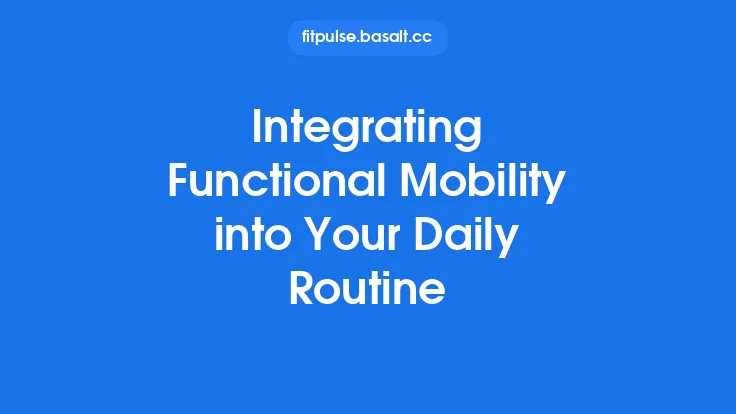Integrating mobility work into a comprehensive fitness program is more than a simple add‑on; it is a strategic component that enhances movement quality, supports strength development, and promotes long‑term health. When mobility drills are thoughtfully woven into age‑appropriate training plans, they become a catalyst for functional performance rather than an isolated activity. This article explores how to embed mobility drills within the broader context of youth, adult, and senior fitness regimens, emphasizing assessment, programming logic, progression, and ongoing evaluation.
Understanding Mobility Drills vs. Static Stretching
Mobility drills are dynamic, often multi‑joint movements that challenge a joint’s range of motion (ROM) while simultaneously demanding muscular control, coordination, and neuromuscular activation. In contrast, static stretching typically isolates a muscle group, holding a lengthened position for a set duration without significant load or movement.
| Feature | Mobility Drills | Static Stretching |
|---|---|---|
| Movement | Dynamic, often repetitive | Passive, held |
| Load | Bodyweight or external resistance | Minimal to none |
| Neuromuscular Demand | High – requires motor control | Low – primarily sensory |
| Training Effect | Improves functional ROM, joint stability, and movement patterns | Increases passive flexibility, may temporarily reduce strength |
Recognizing this distinction is crucial when deciding where mobility drills belong in a training plan: they are best placed where movement quality and strength intersect, rather than at the end of a session as a “cool‑down” stretch.
Core Principles for Age‑Appropriate Integration
- Functional Relevance – Choose drills that mirror the movement demands of the individual’s daily activities or sport. A teenager training for basketball will benefit from hip‑openers that support lateral cutting, while a senior aiming to maintain independence may prioritize ankle dorsiflexion for safe stair navigation.
- Load Compatibility – Align the intensity of mobility work with the surrounding training load. Heavy strength days may call for low‑volume, high‑quality mobility drills, whereas lighter conditioning days can accommodate higher volume.
- Progressive Overload – Just as with strength training, mobility drills should be progressively challenged by increasing range, adding external load (e.g., weighted bands), or incorporating complex movement patterns.
- Recovery Balance – Mobility work can be both a stimulus and a recovery tool. Ensure that the volume and intensity do not compromise the recovery needs of the specific age group.
- Individual Variability – Biological age, training history, and health status dictate the starting point and progression speed. Use objective assessments to tailor the plan.
Assessing Baseline Mobility Across Life Stages
A data‑driven approach begins with a systematic mobility screen. The following assessments provide quantifiable metrics that can be tracked over time:
| Age Group | Key Assessment | Target Metric | Interpretation |
|---|---|---|---|
| Youth (12‑18) | Modified Thomas Test (hip flexor) | ≤ 10° hip extension deficit | Indicates need for hip flexor mobility work |
| Overhead Squat Assessment | Depth ≥ 90° | Reflects combined ankle, hip, thoracic mobility | |
| Adult (19‑64) | Shoulder Flexion with Scapular Plane | ≥ 180° | Adequate for most overhead activities |
| Single‑Leg Balance with Reach | ≤ 5 cm sway | Suggests sufficient ankle‑hip integration | |
| Senior (65+) | Sit‑to‑Stand Reach Test | Reach ≥ 5 cm beyond toes | Demonstrates functional ankle‑knee‑hip mobility |
| Cervical Flexion/Extension ROM | ≥ 30° each direction | Supports safe head‑turning and posture |
Documenting these values creates a baseline from which to prescribe appropriate drill intensity and to monitor progress.
Designing a Balanced Fitness Plan: Where Mobility Fits
A typical weekly macro‑cycle can be visualized as a three‑column matrix: Strength/Power, Conditioning, and Mobility/Movement Quality. The proportion of each column shifts with age and training goals.
| Age Group | Strength/Power | Conditioning | Mobility/Movement Quality |
|---|---|---|---|
| Youth | 40% (skill‑based lifts, bodyweight) | 30% (games, interval) | 30% (dynamic drills) |
| Adult | 45% (periodized resistance) | 35% (cardio, HIIT) | 20% (targeted mobility) |
| Senior | 30% (functional resistance) | 30% (low‑impact cardio) | 40% (mobility & stability) |
Placement within a session
- Pre‑Strength: Light, activation‑focused mobility (e.g., banded thoracic rotations) to prime the joint for load.
- Inter‑Set: Short, high‑quality mobility bursts (e.g., 30‑second ankle dorsiflexion with a mini‑band) to maintain joint health without excessive fatigue.
- Post‑Conditioning: Longer, controlled mobility sequences that reinforce movement patterns learned earlier in the session.
Youth Fitness Plans – Practical Integration Strategies
- Skill‑Centric Mobility
- Pair mobility drills with sport‑specific skill work. For a young soccer player, integrate “walking lunges with torso rotation” immediately before dribbling drills to reinforce hip‑thoracic coupling.
- Play‑Infused Mobility
- While avoiding the “Youth Mobility Play” article’s content, embed mobility within game‑like scenarios: a “cone‑to‑cone hop” that requires hip abduction and external rotation, encouraging natural movement exploration.
- Frequency & Volume
- 2–3 sessions per week, each lasting 8–10 minutes, focusing on high‑repetition, low‑load drills (e.g., 15 × dynamic hip circles per side). This aligns with the higher recovery capacity of adolescents.
- Progression Cue
- Introduce external load gradually (e.g., light ankle weights) once the athlete can perform the drill with perfect form for three consecutive sessions.
Adult Fitness Plans – Practical Integration Strategies
- Periodized Mobility Blocks
- Allocate a 4‑week “mobility emphasis” block within a macro‑cycle, increasing drill complexity (e.g., from bodyweight deep squat to goblet squat with a pause at the bottom). This mirrors strength periodization principles.
- Hybrid Strength‑Mobility Sets
- Combine a strength movement with a mobility finisher: 3 × 5 × 5 back squats followed by 2 × 30 seconds of “hip flexor stretch with banded activation” to maintain hip extensibility.
- Time‑Efficient Integration
- For busy professionals, embed 5‑minute mobility circuits during “active rest” periods in a circuit training class, ensuring no additional session time is required.
- Monitoring Load
- Use a simple RPE (Rate of Perceived Exertion) scale for mobility drills (0–10). Aim for 4–6 during integration phases to avoid excessive fatigue that could compromise subsequent strength work.
Senior Fitness Plans – Practical Integration Strategies
- Joint‑Protection Emphasis
- Prioritize drills that enhance joint congruency and proprioception, such as “slow controlled heel‑toe walks with a mini‑band around the forefoot” to improve ankle stability without high impact.
- Mobility as Recovery
- Schedule mobility sessions on “active recovery” days, using low‑intensity, high‑control movements (e.g., seated thoracic rotations with a light towel) to promote circulation and joint lubrication.
- Progressive Load with Safety
- Introduce light resistance (e.g., 1–2 lb ankle cuffs) only after the senior demonstrates consistent, pain‑free execution for at least two weeks. Emphasize slow tempo (3‑second eccentric, 2‑second hold, 3‑second concentric).
- Integration with Functional Tasks
- Pair mobility drills with everyday activities: “sit‑to‑stand with a hip hinge cue” that simultaneously trains hip mobility and lower‑body strength, directly translating to improved independence.
Periodization and Progression of Mobility Work
Mobility drills can be periodized using the same macro‑, meso‑, and micro‑cycle framework applied to strength training.
- Macro‑Cycle (12‑16 weeks): Define overarching mobility goals (e.g., improve thoracic extension by 15°).
- Meso‑Cycle (4‑6 weeks): Focus on specific joint groups, increasing drill complexity or load each week.
- Micro‑Cycle (weekly): Adjust volume and intensity based on fatigue levels and performance metrics.
Progression Variables
- Range of Motion – Incrementally increase the depth or angle of the movement.
- Load – Add bands, light dumbbells, or weighted vests.
- Complexity – Transition from single‑joint to multi‑joint patterns (e.g., from ankle dorsiflexion to a full “lunge with thoracic rotation”).
- Tempo – Slow the eccentric phase to enhance tissue remodeling.
A practical example for adults:
- Weeks 1‑2: 3 × 10 seconds of banded shoulder dislocates (light band).
- Weeks 3‑4: 3 × 12 seconds with a medium‑resistance band.
- Weeks 5‑6: 3 × 15 seconds, adding a 2‑kg dumbbell held overhead to increase scapular load.
Monitoring, Feedback, and Adjustments
Continuous feedback loops ensure that mobility integration remains effective and safe.
- Objective Re‑Testing: Re‑assess the baseline mobility tests every 4–6 weeks. A 5‑10% improvement in ROM typically signals appropriate progression.
- Subjective Metrics: Track perceived joint stiffness, soreness, and functional ease (e.g., “Can I squat to parallel without discomfort?”).
- Performance Correlation: Observe changes in strength or conditioning outputs. Improved mobility often translates to better squat depth, increased stride length, or smoother gait.
- Adjustment Protocol: If a drill causes persistent discomfort or stalls progress, reduce load, simplify the movement, or replace it with an alternative that targets the same joint.
Common Pitfalls and How to Avoid Them
| Pitfall | Why It Happens | Remedy |
|---|---|---|
| Treating Mobility as a “Finish‑Line” Stretch | Perception that mobility is only for post‑workout cooling | Embed mobility throughout the session, not just at the end |
| Excessive Volume with Low Quality | Belief that “more is better” | Prioritize technique; keep sets short (30‑60 seconds) and focus on control |
| Neglecting Age‑Specific Recovery Needs | Using the same frequency for all ages | Adjust session frequency: youth (3‑4 × week), adult (2‑3 × week), senior (2 × week or integrated into active recovery) |
| Over‑Loading Early | Desire for rapid gains | Follow a graduated load progression; start with bodyweight before adding resistance |
| Ignoring Functional Transfer | Selecting drills that don’t mimic daily or sport movements | Choose drills that replicate the joint angles and patterns used in the individual’s primary activities |
Tools and Resources for Effective Integration
- Mobility Assessment Apps: Platforms that allow video capture and angle measurement (e.g., Coach’s Eye, Kinovea) for precise baseline data.
- Resistance Bands with Color‑Coding: Simplify load progression and ensure consistent tension across age groups.
- Mobility‑Specific Training Logs: Include columns for ROM, RPE, and qualitative notes to track trends over time.
- Educational Modules: Short, evidence‑based videos on joint biomechanics help coaches and clients understand the “why” behind each drill.
- Professional Networks: Forums such as the National Strength and Conditioning Association (NSCA) or the American College of Sports Medicine (ACSM) provide peer‑reviewed protocols and case studies.
Final Thoughts
Integrating mobility drills into age‑appropriate fitness plans transforms mobility from a peripheral activity into a central pillar of functional health. By grounding the process in systematic assessment, aligning drills with the broader training load, and applying age‑sensitive periodization, practitioners can enhance movement quality, support strength development, and promote lifelong independence. The result is a cohesive program where every joint moves purposefully, every muscle works synergistically, and every individual—whether a teenager on the field, an adult juggling work and workouts, or a senior seeking vitality—reaps the lasting benefits of well‑structured mobility integration.





